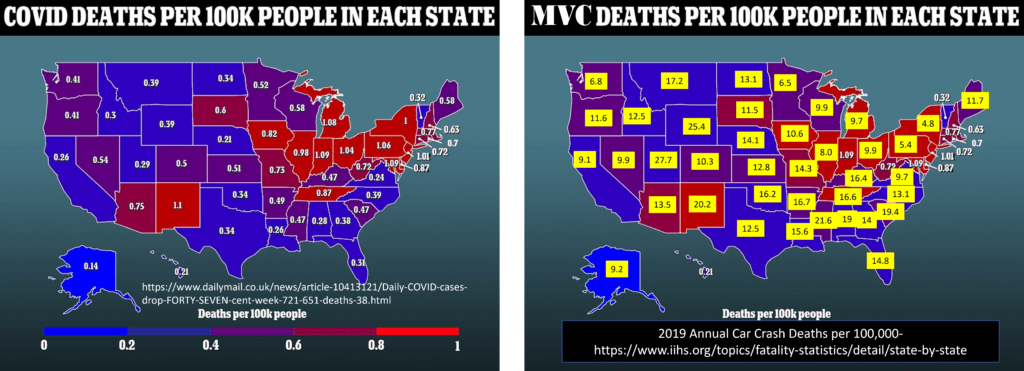COVID Death Rates vs. Car Crashes?

Credit: Shutterstock
Yesterday I was reading comments by former FDA commissioner Scott Gottlieb that the pandemic was over. In that same news piece was an infographic on COVID death rates per 100,000. That caused me to look up car crash death rates by state using the same metrics and I wasn’t surprised by the comparison. What did I find? Let’s dig in.
The End of the Pandemic?
Former FDA commissioner Scott Gottlieb was interviewed yesterday (1). He believes that the Omicron variant is now waning and that the next few weeks will herald the end of the pandemic due to the additional widespread immunity gained by this mild infection. He also feels at that point, COVID will be endemic like the flu. That of course was just about the opposite of what Dr. Fauci had said, so this interview of Dr. Gottlieb hit many news outlets.
In reading a story on this statement (2), there were several infographics which were US maps with various rates per 100,000 such as infections, hospitalizations, and deaths. The death rate was interesting to me as it fit well with what I had already blogged about the CDC and Berkely Omicron paper showing that this was about 1 in 50,000 infections. So I wondered, could I get the same deaths per 100,000 people for car crash statistics and how would they compare?
COVID Deaths versus Car Crashes

What’s being shown here? On the left is the original graphic showing the deaths per 100,000 people last week in each state. Note that these rates are roughly in the same ballpark as the CDC/Berekely paper. Also, note that this is still likely a mix of the last and more lethal Delta cases hanging on and perishing late plus the less-lethal Omicron. On the right, I looked up the 2019 IIHS death rate by state and added those in yellow (3). I didn’t do all of the small states, just the bigger and easier to modify states to show the general comparison.
What do you see? The 52-week car crash rates are of course much higher than the one-week COVID deaths. However, how much higher is what’s fascinating. Let’s compare some states head to head while adjusting the current COVID death rate for the whole year:
- Texas: 0.34×52=17.7 annual COIVID deaths per 100,000. Now let’s compare that to car crashes for 2019 which were 12.5/100,000.
- California: 13.5 COVID deaths/100,000 vs. 9.1 car crash deaths/100,000
- Florida: 16.2 for COVID and 14.8 for car crashes
For many states, your likelihood of perishing from COVID last week was similar to your likelihood of dying in a car crash for 2019. In fact, the two rates only get out of whack in the states that are very safe at driving and have high COVID death rates per 100,000. Take for example New York at 1 COVID death per 100,000 which would produce 52 deaths per year compared to 4.8 deaths from car crashes. However, even in that situation, the current COVID death rate is only about 10X higher.
Of note, these COVID death rates will likely decrease in the next few weeks as all of the Delta cases wash out of the hospital system and all of the cases represented are the much less lethal Omicron.
A Thought Experiment
Let’s say you live in California and I stop you to tell you about the risk of your drive to work. I tell you that your risk of death in any year is about 13.5 per 100,000 people. Are you going to cancel your trip? Very unlikely. In fact, you would likely tell the crazy person holding up your trip to get lost and get in your car and drive away. Even if you lived in New York and I told you the death rate was 52 in 100,000 people for one year, you would still get in your car and drive away.
Why the Grim Predictions on Deaths?
It’s very clear that the mortality rate of Omicron is very very small. It’s also very clear that only the frailest are dying from Omicron, just as any number of people perish every year from infections that most of us shake off without a thought. The only concern with Omicron is that because it’s very infectious, many more people are getting exposed very quickly and thus the total number of deaths will go up. However, that doesn’t change the low rate of death. The same would happen to the number of car crash deaths if we suddenly forced a much bigger number of Americans to be on the roads at the same time, which is what happens on holidays like Thanksgiving.
What Should You Do?
First, please live your life. The existing data shows that for an otherwise healthy person, Omicron is no reason to panic and hide out in your basement. However, continue to wash your hands, get vaccinated, wear a mask where recommended, and protect the frail. Notice that I’m not saying the elderly, as the CDC data shows that the elderly were no more likely to die from Omicron than the young. The focus should be on those in nursing homes, those who are immunocompromised or living medically on the edge of life and death. All of the same people we would protect in the average severe flu season.
The upshot? If you’re not afraid to drive to work or the grocery store, you shouldn’t fear Omicron. Live your life and avoid watching too much news.
_____________________________________________
References:
(1) https://twitter.com/SquawkCNBC/status/1483424996613578756?ref_src=twsrc%5Etfw
(2) https://www.dailymail.co.uk/news/article-10413121/Daily-COVID-cases-drop-FORTY-SEVEN-cent-week-721-651-deaths-38.html
(3) https://www.iihs.org/topics/fatality-statistics/detail/state-by-state

If you have questions or comments about this blog post, please email us at [email protected]
NOTE: This blog post provides general information to help the reader better understand regenerative medicine, musculoskeletal health, and related subjects. All content provided in this blog, website, or any linked materials, including text, graphics, images, patient profiles, outcomes, and information, are not intended and should not be considered or used as a substitute for medical advice, diagnosis, or treatment. Please always consult with a professional and certified healthcare provider to discuss if a treatment is right for you.
